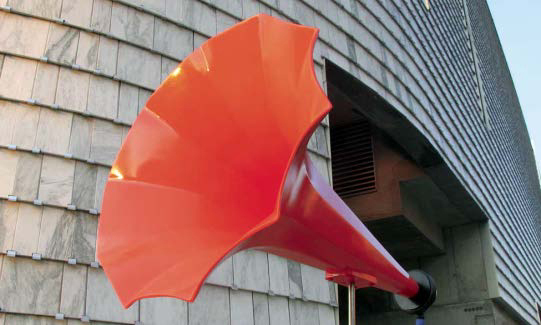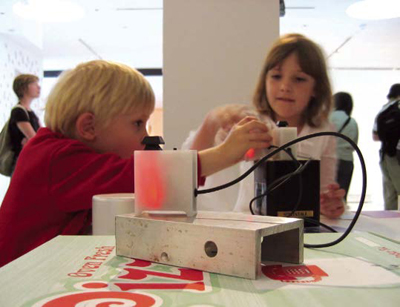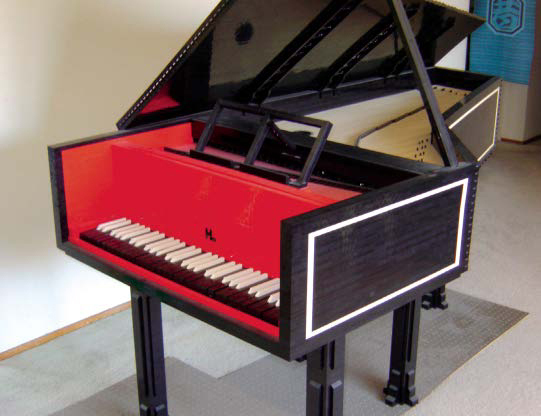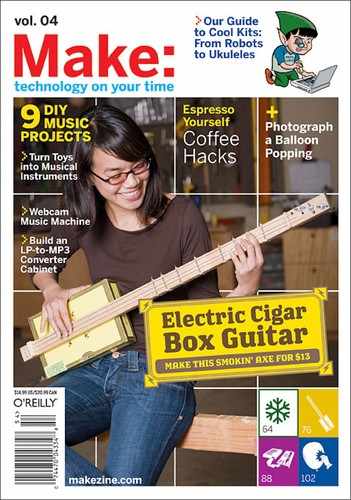MADEONEARTH
Report from the world of backyard technology

Photography by Daniel Jolliffe and Jessica Larva
Speak Your Mind
If you’re walking through your local park and happen upon a device looking like something out of Yellow Submarine with loud random voices blaring from it, you’ve found Daniel Jolliffe’s “One Free Minute.”
Designed to promote anonymous public speech, One Free Minute allows calls to the cellphone inside the sculpture to be connected for exactly one minute to a 200-watt amplifier and speaker. The results can be empowering, funny, touching, and downright loud. The speech produced by Jolliffe’s sculpture can be heard clearly for more than 150 feet.
The 41-year-old Canadian artist created One Free Minute for his master’s thesis project at Ohio State University. It’s attached to a bicycle for easy movement, and he’s taking it on tour throughout the U.S. and Canada.
There’s clearly a political aspect to One Free Minute. By creating a tool that allows anonymous free speech in public places, Jolliffe hopes to let activists speak without fear or recrimination at a time when governments everywhere are increasingly vigilant of who is saying what and where.
The sculpture was designed in Rhino CAD, which offers a wide range of visualization options. Once Jolliffe settled on the look he wanted, he used a process similar to building a wooden boat, creating the shell out of fiberglass and epoxy and then sanding — lots of sanding.
The electronics turned out to be the easy part. Jolliffe assembled the embedded controller by hand, threw in an off-the-shelf car stereo amplifier, a couple of gel cell batteries, a 200-watt compression driver, and a serially controlled MP3 player. The sculpture was ready to make some serious noise.
From the woman who called to say she had pancreatic cancer and wanted to tell her children she loved them before she died, to political ranters, to silly singers, Jolliffe credits them all. “The people who call up and lay their guts on the line, saying what they really think — this piece was built for them and they are the real creators of what is good about One Free Minute.”
If you want to speak live, send email to [email protected] and you’ll receive the live number before the next performance. You can also call a number anytime to record your message (see website for numbers) or send MP3 files for public broadcast.
—Bruce Stewart
To make your own cellular megaphone, see page 129.
![]() One Free Minute: onefreeminute.net
One Free Minute: onefreeminute.net
![]() See One Free Minute in action at makezine.com/04/made.
See One Free Minute in action at makezine.com/04/made.



Photography by Ben Dove
Slap That String
Sitting behind a laptop is boring, but how do you invent a new musical instrument for “playing” the computer? Musician and interactive designer Ben Dove needed a new solution, and he didn’t want to simply mimic traditional instruments. So he started with the sensing technology first. His “String Thing” uses a combination of laser-powered motion tracking, metal rods for sensing finger pressure, and even a vibration system for physical feedback. Plug it into a computer, and you can expressively play the rods with your fingers: position controls pitch, and pressure controls volume. The result may look like a strange robotic cello, but playing it is a totally new experience.
If this sounds hard to perfect, it was. Dove admits getting the positioning system to work was a nightmare. “I spent so long trying things,” he says. “I just could not believe it was such a big deal!” The current model, Dove’s thesis project at Italy’s Interaction Design Institute Ivrea, is the latest of a long string of prototypes. The first was constructed from a clothes hanger, guitar string, and DV tape. Later, he settled on suspended metal rods for pressure. The motion tracking system uses a webcam connected to the free PC software EyesWeb, which “watches” reflected laser dots on the player’s fingers.
The work has paid off: while Dove has more refinements planned, the instrument is already fun to play. Dove’s own playing has been “trance inducing, very droney,” but others have successfully tried it, too. Some attempted to pluck it, which won’t work, but others “seemed to instantly get it — [their playing] sounded better than my efforts!” Move over, Stradivarius, Theremin, and Les Paul: there’s a new axe in town.
—Peter Kirn
![]() String Thing’s construction: people.interaction-ivrea.it/b.dove/string_thing/
String Thing’s construction: people.interaction-ivrea.it/b.dove/string_thing/
![]() Hear String Thing at makezine.com/04/made.
Hear String Thing at makezine.com/04/made.

Photograph by Steve Lodefink
Testing Your Mettle with Iron Age Skills
The digging stick was a neat invention, and stone tool-making traditions came in handy for a few million years. But metallurgy, specifically humans’ discovery of how to turn lumps of red dirt into workable slabs of iron, really opened up the technological floodgates. Blacksmiths had to have skills as designer, engineer, and metalworker in order to make best use of this precious commodity.
With the Industrial Revolution, blacksmiths became nearly extinct. A few skilled artisans prospered by adorning the mansions of the new industrial barons with beautiful hand-forged ironwork. Today, Seattle artist blacksmith Maria Cristalli wields her hammer primarily in the service of pounding out incredible hand-forged architectural metalwork for the palaces of today’s Silicon Revolution tycoons.
Formally educated in fine arts, Cristalli started a career as a photographer, but when she took a welding class one day, metal got under her skin and there was no looking back. Cristalli’s metal-working skills have evolved through a long series of apprenticeships, workshops, and time at the anvil.
The hand forging process is much like it has been for hundreds of years. A bar of metal is heated up in a furnace until it reaches its red-hot working temperature, and the blacksmith then works the piece with hammers, anvil, and huge amounts of skill until the design emerges.
Cristalli’s architectural pieces are in high demand, and her commissions include an elaborate iron wishing-well cover with stylized acanthus leaves, an Antonio Gaudi-inspired home interior, numerous fireplace surrounds, gates, and various home and garden accessories. When Cristalli gets burned out on botanical designs and scrollwork, she turns out clean contemporary furnishings and sculpture. Ironing really is women’s work.
—Steve Lodefink
![]() Maria Cristalli’s site: mariacristalli.com
Maria Cristalli’s site: mariacristalli.com

Photograph by Larry Cotton
Marimba Madness
Talk about stubborn. Larry Cotton, a retired engineer from New Bern, N.C., didn’t want PC hardware anywhere near his elegant marimba, even though it would have made things a lot easier. Most makers connect instruments to a computer via MIDI or some other common interface. Cotton had to rig up a low-tech optical reader inside the marimba to play custom piano rolls. “I was just kind of doing my own thing, committed to using nothing that existed already,” says Cotton.
He started with photodiodes and 300-pound fishing line. He shined spotlights through the thick monofilament, creating a cheap fiber optic system. He lined up 40 spots across 4 inches of makeshift roll, each one accounting for one of the 37 handmade oak bars around the circular instrument. An inkjet printer furnished black dots on the transparency, and when the dots blocked light, a voltage change from the photodiodes registered to Schmitt triggers and 555 timers.
Each hand-soldered circuit drove relays and higher-current solenoids (former cassette player mechanisms bought surplus).
Cotton makes custom rolls himself by playing songs on his piano and capturing the audio on his workshop PC. By running it through Cakewalk 6.0 software, Cotton is able to reformat the MIDI computer dots to play in his machine.
The oddly shaped marimba pounds out a mean version of Flight of the Bumble Bee, along with the old Carmen Miranda tune “Tico Tico” and other songs. But like nearly all player instruments, you can tell the difference. Asked if there are times you can almost close your eyes and hear a human player, Cotton laughs. “Oh, yeah,” he says. “A pretty bad one.”
—Bob Parks
Unroll Your Own Art-O-Matic Reflex
If Cinderella had used duct tape to fashion her gown, she wouldn’t have needed those fairy godmothers, and two teens in Oklahoma have proved it. For their winning entry in the 2004 annual Duck Brand Duct Tape “Stuck at Prom” Scholarship Contest, high school students Casey Isringhouse and Krystal Long constructed royalty-themed prom wear out of duct tape to win the prize, a $2,500 college scholarship. Interested in entering next year? Read the Contest FAQs for tips, such as this: “the entire outfit does not have to be 100% duct tape. However... full duct tape attire [is] a plus.”
—Arwen O’Reilly
![]() Stuck at Prom Scholarship Contest: makezine.com/go/ducktape
Stuck at Prom Scholarship Contest: makezine.com/go/ducktape

Photograph by Duck brand Duct Tape (Unroll Your Own) and photograph by Clark Whittington (Art-O-Matic Reflex)
Clark Whittington began repurposing vintage cigarette-vending machines in 1997 to vend art instead of smokes. Now Art-o-mats are available in cities all over the United States. At $5 a pop, it can hardly be called a dangerous addiction. And, more importantly, it’s a unique transaction: you have an original work of art in your hands. But Whittington is quick to point out “It’s the artists who are doing whiz bang work. And many times, it’s the first [art] purchase for the buyer.”
Artists submit their work, Whittington and friends evaluate it (Is it worth five bucks? Will it fit in a box the size of a cigarette package?), package it, and supply the far-flung machines. The low price tag erases the elitist associations many people have with art, and the machine, by making explicit the relationship between art and money, pokes fun at more pretentious galleries.
Although the Art-o-mat has in fact led to gallery shows for some of its artists, the machines are doing just fine, thank you. In Chicago alone, there are 3,000 sales a year. Not quite enough to retire on, maybe, but then, that’s not the point: the art is.
—Arwen O’Reilly
![]() Art-o-mat: artomat.org
Art-o-mat: artomat.org


Photograph by Andy Huntington
Think Inside the Box
If you find yourself constantly tapping your desk, you’ll love this: Beatbox, created by Andy Huntington while studying at the Royal College of Art, London. Beatbox is a series of tapping boxes. You can teach each box a rhythm by tapping it, and it will replay by tapping any surface you attach it to.
“I had been working with tapping toys for the last 18 months, based around solenoids, and became interested in being able to use them to release the acoustic properties of everyday items,” he explains.
To teach a box, you press the record button, turning the LED inside red. Tap a sequence, and then press the play button, turning the box green. The box will then accurately tap your rhythm until you record a new one or tell it to stop. By attaching boxes to a variety of surfaces, it is possible to create a wide range of sound textures, so get out your kitchen pots, pans, and pizza boxes!
Beatbox has two modes: the first has each tapper box looping around its own clock, and the other syncs all the tappers to a central loop time. It is also possible to change the overall rhythm speed from the central box.
Developed using PIC chips, solenoids, computer keyboard buttons, LEDs, self-assembled acrylic boxes, and some custom PCBs, the boxes glow white upon each tap, creating a mini light show and a visual indicator for each beat.
Huntington, who is currently looking at turning Beatbox into a commercial product, wanted to get away from a computer-based timeline metaphor by creating a physical interface. The result: an instrument that’s easy to pick up and play, yet flexible enough to create more complicated beats. Simple but perfect.
—Chris O’Shea
![]() Beatbox: extraversion.co.uk/beatbox/
Beatbox: extraversion.co.uk/beatbox/
![]() See a video of Beatbox in action at makezine.com/04/made.
See a video of Beatbox in action at makezine.com/04/made.

Photograph by Henry Lim
Baroque Bricks
What does someone who is equally serious about LEGO and Bach do in their spare time? Make a fully functional LEGO harpsichord, of course.
Requiring around 100,000 LEGO pieces and two years of theorizing, designing, collecting parts, building, testing, and rebuilding, Henry Lim’s harpsichord was definitely a labor of love. Lim is a prolific LEGO artist (see henrylim.org/LEGOSculptures.html), but the harpsichord was the most difficult and ambitious LEGO project he’s taken on so far.
The most important design considerations were strength, efficiency, and durability. The instrument had to be strong enough to support the tension of the strings, as well as be able to withstand the repeated movements required of a keyboard instrument. The final design relied heavily on the larger 2x8 and 1x16 bricks and 6x8 and 6x16 plates to achieve the necessary strength. With the exception of the strings, every single part of Lim’s harpsichord is made of LEGO.
“LEGO as a medium holds rather well, not to mention it’s heavier than hell on a compoundedly large scale,” points out the 33-year-old Lim, who currently has the life-sized harpsichord on display in his living room in Redondo Beach, Calif.
Acoustically, the harpsichord needed to be as smooth as possible, so instead of having the standard LEGO studs exposed, Lim covered these up with smooth-topped flat tiles. The end result is a sound as resonant as LEGO will get.
While musically the LEGO harpsichord leaves a little to be desired — “Tuning it is a bitch,” explains Lim — that really wasn’t the point. Lim’s working harpsichord is a majestic LEGO engineering feat.
—Bruce Stewart
![]() LEGO Harpsichord: henrylim.org/Harpsichord.html
LEGO Harpsichord: henrylim.org/Harpsichord.html
![]() Hear Lim’s harpsichord at makezine.com/04/made.
Hear Lim’s harpsichord at makezine.com/04/made.

Photograph by Dennis Palatov
Light Makes Right
Most people would consider the Westfield Megabusa, a 1,000-pound sports car with 175 horsepower, a scarily fast car. But when Dennis Palatov finished building his Westfield, it just whetted his appetite for an even more extreme car. He started designing his own, the dp1. His goal: a trackday car with an insane power-to-weight ratio and a top speed of 160 MPH. How to do it: increase power or decrease weight. Palatov ruthlessly attacked the latter, setting the target weight for the car at just 700 pounds.
The rest of the dp1’s design flowed from the weight target. Two people weigh more than one, so it’s a single seater. A smaller frame is lighter, so he located the engine beside the driver, pulled the ends of the car closer together, and used tiny, 13-inch-diameter wheels. Instead of a drive shaft, the dp1 uses a chain drive like a motorcycle and a lightweight, turbo-charged Suzuki Hayabusa motorcycle engine. The body is carbon fiber (what else?) on a steel space frame. The car has no radio, air conditioning, carpet, roof, trunk, windshield, or place to hang your fuzzy dice. Its lightness doesn’t get in the way of high performance, though: it has a full undertray to generate aerodynamic downforce, and all-wheel drive to claw its way out of corners.
The dp1’s design process has been just as high-tech as the dp1 itself. The parts were fabricated from CAD files designed by Palatov, and the car’s aerodynamics were simulated in a software wind tunnel. He’s posted progress reports, enginering drawings, and photos on his blog, and has used LazyWeb (online requests for help) to solve design problems and find specialized fabricators.
Three years into the project, the dp1 is almost ready to roll. Best of all, Palatov is now a manufacturer. He’ll build a dp1 for you, too.
—Bob Miller
![]() Dennis Palatov’s dp1 build log: dpcars.net/dp1bld
Dennis Palatov’s dp1 build log: dpcars.net/dp1bld
![]() Palatov’s design log: dpcars.randomresearch.com/dp1
Palatov’s design log: dpcars.randomresearch.com/dp1
Build and Program your own Robot!
The Boe-Bot® robot is built on a high-quality brushed aluminum chassis that provides a sturdy platform for the continuous rotation servo motors and BASICStamp®module’s Board of Education carrierboard. Many mounting holes and slots may be used to add custom robotic equipment or off-the-shelf Parallax add-ons. What really makes the Boe-Bot unique is the BASIC Stamp microcontroller’s flexibility of programming when coupled with breadboard circuit construction. Following along in Robotics with the Boe-Bot, users quickly learn about embedded projects, from wiring and components to programming and mechanical dependencies.
The Boe-Bot robot takes about 1-2 hours to put together, though each project in the text provides a unique new experience of wiring and source code tuning. Completing the entire set of projects takes 50 hours and is suitable for anybody over 12 years of age. The Board of Education® (and #BS2-IC) may also be removed to be used as your platform for other projects.

Boe-Bot Full Kit-$179
Serial version; #28132
USB version; #28832
To order visit www.parallax.com or call Toll-Free 888-512-1024 (Monday-Friday, 7 a.m. - 5 p.m., PT).
Boe-Bot, BASIC Stamp, and Board of Education are registered trademarks of Parallax, Inc. Parallax, and the Parallax logo are trademarks of Parallax, Inc.
